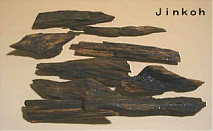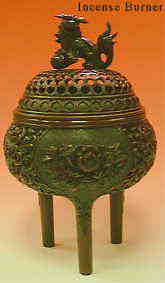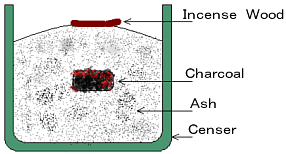While the aesthetic practice of Koh-do (literally, the Way of Incense, and commonly translated as Incense Ceremony) is a product of Japanese culture, the incense ingredients used for Koh-do are not indigenous to Japan. Unlike tea, which was originally imported from China but was later cultivated in Japan, incense wood (aloeswood) still comes from the tropics of Southeast Asia.
The aromatic aloeswood is called jinkoh in Japanese, or sometimes simply jin, meaning "sinking-in-water" incense. Not all wood the Japanese refer to as jinkoh sinks in the water, however. If it is not oily or resinous enough it may folat, and be less aromatic and thus of less value.
 The aromatic property of jinkoh was once believed that it formed only over a long period of time after an old and diseased aloeswood tree had died, fallen, and been buried under leaves and soil. However, more recently this aromatic property has been discovered in living trees belonging to the daphne family. The color of jinkoh is generally dark brown or black. The more resinous the wood, the darker, heavier, and more aromatic it becomes. This biochemical change is extremelly rare, however, and it takes a highly experienced person to find such aromatic wood either buried underground, or in a liveng tree in the jungle.
The aromatic property of jinkoh was once believed that it formed only over a long period of time after an old and diseased aloeswood tree had died, fallen, and been buried under leaves and soil. However, more recently this aromatic property has been discovered in living trees belonging to the daphne family. The color of jinkoh is generally dark brown or black. The more resinous the wood, the darker, heavier, and more aromatic it becomes. This biochemical change is extremelly rare, however, and it takes a highly experienced person to find such aromatic wood either buried underground, or in a liveng tree in the jungle.
Incense use had been introduced to Japan along with Buddhism by the middle of the sixth century via the Korean peninsula and was already a part of the higher classes. As a zealous supporter of Buddhism, Prince Shotoku (A.D. 574-622) was well acquainted with this fragrance from Buddist rituals, which could not be performed without incense.
 The incense used in ancient Japanese Buddhist rituals was at first a mixture of five to seven chipped aromatic materials. This kind of incense was sprinkled directry on hot burning charcoal on the ashes. After the technique of making joss-stick incense was introduced to Japan in the sixteenth century, it became as common as chipped incense in Buddhist rituals for the ease with which it was burned. Although joss-stick incense was also burned for pleasure, the Japanese have long associated it with Buddist rituals. Fragrance was believed to help invoke the Budda's presence and summon forth his peaceful world.
The incense used in ancient Japanese Buddhist rituals was at first a mixture of five to seven chipped aromatic materials. This kind of incense was sprinkled directry on hot burning charcoal on the ashes. After the technique of making joss-stick incense was introduced to Japan in the sixteenth century, it became as common as chipped incense in Buddhist rituals for the ease with which it was burned. Although joss-stick incense was also burned for pleasure, the Japanese have long associated it with Buddist rituals. Fragrance was believed to help invoke the Budda's presence and summon forth his peaceful world.
Japan had sent the official envoys to China during the Nara and early Heian period (the eighth-nineth century), and continued to assimilate Buddhism, retaining the use of incense in the ceremony. One early exponent of ceremonial incense use was the Chinese priest Ganjin(A.D.688-763), who had been invited to setup Buddhist doctrines for the Japanese. Along with the Buddhist creed, he introduced various uses of spices which was already popular in Chaina. The Chinese had been using blended incense for pleasure and medicinal purposes apart from religion, and Heian courtiers quickly adopted the recipes.
 This new way of using fragrance apart from religious usage was called "soradaki"(empty burning), making it different form "sonae-koh"(incense offering to Buddha). The emptiness refers to the lack of a religious purpose. The appreciation of incense by scenting a room or clothes, or by playing incense-comparison games, developed into the art of incense, or Koh-do. Through experimentation, the courtiers began to adapt the use of incense in still more innovative ways.
This new way of using fragrance apart from religious usage was called "soradaki"(empty burning), making it different form "sonae-koh"(incense offering to Buddha). The emptiness refers to the lack of a religious purpose. The appreciation of incense by scenting a room or clothes, or by playing incense-comparison games, developed into the art of incense, or Koh-do. Through experimentation, the courtiers began to adapt the use of incense in still more innovative ways.
Besides using it for cosmetic and medicinal purposes, they burned incense to enhance the enjoyment of the season, or to get an occasion or the mood of gathering higher. Zen monks use incense for meditation as well as for rituals. Even if you are not a monk, a subtle aroma of incense in the air may help you to concentrate at home and at work. Bringing incense into your daily life is not as exotic an activity as it may seem. It is done as easily as playing music, arranging flowers, preparing coffee or tea.
 The aromatic property of jinkoh was once believed that it formed only over a long period of time after an old and diseased aloeswood tree had died, fallen, and been buried under leaves and soil. However, more recently this aromatic property has been discovered in living trees belonging to the daphne family. The color of jinkoh is generally dark brown or black. The more resinous the wood, the darker, heavier, and more aromatic it becomes. This biochemical change is extremelly rare, however, and it takes a highly experienced person to find such aromatic wood either buried underground, or in a liveng tree in the jungle.
The aromatic property of jinkoh was once believed that it formed only over a long period of time after an old and diseased aloeswood tree had died, fallen, and been buried under leaves and soil. However, more recently this aromatic property has been discovered in living trees belonging to the daphne family. The color of jinkoh is generally dark brown or black. The more resinous the wood, the darker, heavier, and more aromatic it becomes. This biochemical change is extremelly rare, however, and it takes a highly experienced person to find such aromatic wood either buried underground, or in a liveng tree in the jungle.
 The incense used in ancient Japanese Buddhist rituals was at first a mixture of five to seven chipped aromatic materials. This kind of incense was sprinkled directry on hot burning charcoal on the ashes. After the technique of making joss-stick incense was introduced to Japan in the sixteenth century, it became as common as chipped incense in Buddhist rituals for the ease with which it was burned. Although joss-stick incense was also burned for pleasure, the Japanese have long associated it with Buddist rituals. Fragrance was believed to help invoke the Budda's presence and summon forth his peaceful world.
The incense used in ancient Japanese Buddhist rituals was at first a mixture of five to seven chipped aromatic materials. This kind of incense was sprinkled directry on hot burning charcoal on the ashes. After the technique of making joss-stick incense was introduced to Japan in the sixteenth century, it became as common as chipped incense in Buddhist rituals for the ease with which it was burned. Although joss-stick incense was also burned for pleasure, the Japanese have long associated it with Buddist rituals. Fragrance was believed to help invoke the Budda's presence and summon forth his peaceful world.
 This new way of using fragrance apart from religious usage was called "soradaki"(empty burning), making it different form "sonae-koh"(incense offering to Buddha). The emptiness refers to the lack of a religious purpose. The appreciation of incense by scenting a room or clothes, or by playing incense-comparison games, developed into the art of incense, or Koh-do. Through experimentation, the courtiers began to adapt the use of incense in still more innovative ways.
This new way of using fragrance apart from religious usage was called "soradaki"(empty burning), making it different form "sonae-koh"(incense offering to Buddha). The emptiness refers to the lack of a religious purpose. The appreciation of incense by scenting a room or clothes, or by playing incense-comparison games, developed into the art of incense, or Koh-do. Through experimentation, the courtiers began to adapt the use of incense in still more innovative ways.